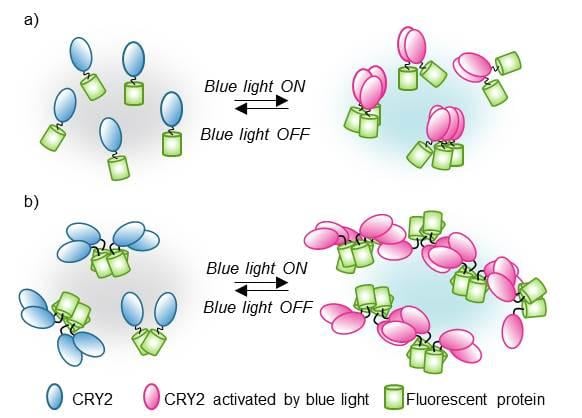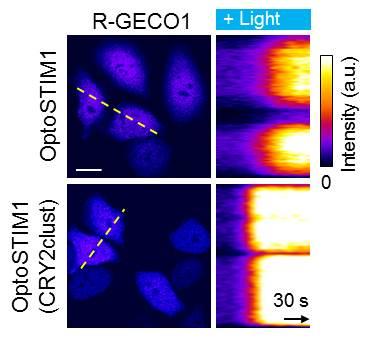An optogenetic technique dubbed CRY2clust is able to trigger protein cluster formation in response to blue light at a faster and more efficient rate than existing methods. CRY2clust is based on a photoreceptor protein called cryptochrome 2 (CRY2), and more specifically, on a part of CRY2 known as CRY2 Photolyase Homology Region (CRY2PHR), which causes this protein to assemble in response to the blue portion of sunlight.

In this optogenetic system, CRY2 (blue and pink) clustering is reversibly controlled by blue light. If CRY2 is linked to fluorescent proteins (green), the clustering timing and features can be visualized and measured by confocal microscope. The scientists hypothesize that if the fluorescent proteins are pre-assembled in pairs or small groups (b), the technique leads to bigger fluorescent clusters. Courtesy of IBS.
CRY2clust consists of CRY2PHR plus nine amino acid residues that have been engineered to maximize its performance. In comparison with other CRY2-derived optogenetic systems, CRY2clust triggers quicker protein association and dissociation when light is turned on and off respectively, resulting in different biological effects. It is functional at lower blue light intensity (90 µw/mm2) than other systems. Because it does not accumulate in nuclear structures, CRY2clust could be useful in the study of nuclear processes.
A research team from the Institute for Basic Science (IBS) identified the determinants for efficient CRY2 clustering and introduced the novel CRY2clust module, which employs diverse fluorescent proteins and an extremely short peptide to induce rapid, efficient homo-oligomerization of target proteins. The team demonstrated the versatility of CRY2clust by comparing it against previously reported optogenetic tools: OptoSTIM1, a light-controlled regulator of calcium channels, and Raf1. In both cases, substituting CRY2clust for CRY2PHR increased the speed and performance of the tools.

In this experiment, either CRY2PHR or the newly developed CRY2clust were bound to a protein that regulates the opening of calcium channels on the cell. Blue light induces this calcium-channel regulator to cluster and as a consequence calcium channels open. The analysis of calcium intake by the cells showed that the new CRY2clust is faster twofold. Higher intensity (yellow-white) means that more calcium entered the cell. Courtesy of IBS.
Limited knowledge of the molecular characteristics of CRY2 obscures its widespread application. Researchers report that the efficiency of CRY2clust varies depending on the type of target proteins bound to CRY2PHR, limiting use of the tool.
“CRY2’s 3D structure has not been defined yet, so we have been trying different strategies to understand how it operates inside cells and to make it more efficient,” said researcher Kim Na Yeon.
The IBS team’s work expands the optogenetic clustering toolbox and provides a potential guideline for designing CRY2-based new optogenetic modules. CRY2clust could advance understanding of molecular and cellular mechanisms.
“We have presented a new dynamic optogenetic tool to study protein homo-oligodimerization, that is clustering, which could be useful for the biologist’s toolkit,” said professor Heo Won Do.
The team is now working on developing additional optogenetic systems to use in neuroscience.
The research was published in Nature Communications (doi:10.1038/s41467-017-00060-2).
mCherry tends to form only little or no clusters when used in combination with the traditional version of CRY2 (CRY2PHR), but when attached to CRY2clust (CRY2PHR-A9) a lot of clusters form rapidly. The video shows the effect of a single pulse of light shone on the cell at the one minute mark (01:00). The fluorescent protein clusters form rapidly and then disassemble. This tool can be applied to study and control specific biological phenomena happening in the cytoplasm, in the nucleus, and on the cellular membrane. Courtesy of IBS.